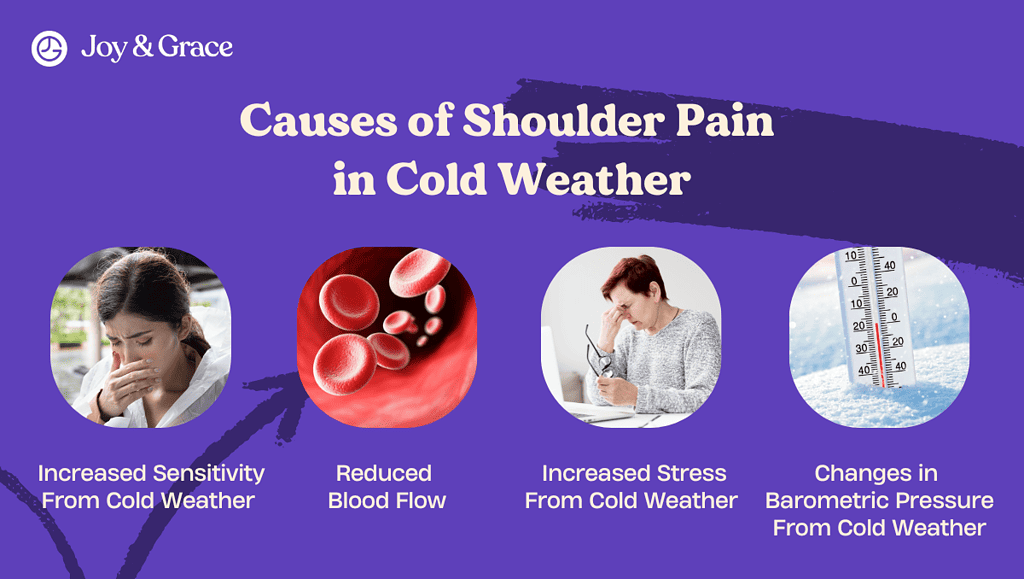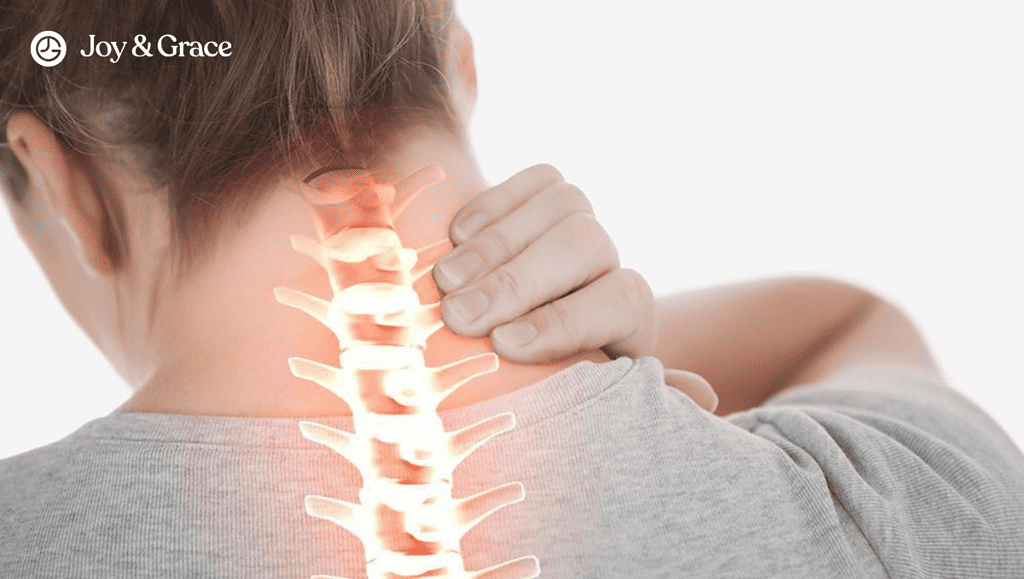Shoulder pain is the third most common complaint following neck and back pain.
It's also one of the hardest to treat because many things can cause it and require different treatments. So many factors could cause your shoulder pain, and it is challenging to know the problem. Shoulder pain can make everyday life difficult and affect your job or hobbies. When combined with cold weather, things get worse.
In one published study, 63% of participants reported being sensitive to changes in weather; among them, 53% reported cold weather increased their musculoskeletal pain.
Let’s discuss why cold weather hurts your shoulder and share some advice on reducing winter flare-ups.
How Cold Weather Affects Your Shoulder Pain: Why Does My Shoulder Hurt During Cold Weather?
Cold weather is thought to hurt your shoulder for several reasons, but the association between the two needs to be better studied.
The shoulder is a complex joint, and many structures are thought to be affected by cold weather.
Here are some of the suggested causes:
Causes of Shoulder Pain in Cold Weather

Increased Sensitivity From Cold Weather
The cold weather conditions can cause your shoulder to become more sensitive than usual.
That's because the muscles and tendons that support your joints are not accustomed to cold temperatures and wind exposure. When muscles get stiff from being out in the cold, they can pull on nearby tissues like tendons and ligaments, resulting in pain and discomfort.
For example, skiing on a very cold day can make you less mobile and cause muscle spasms. Shoulder strains like tendinitis or bursitis are also more common in those cases.
In addition, cold weather can also affect the shoulder nerves that run into the neck. That could lead to headaches, back and neck pain, and shoulder stiffness.
Reduced Blood Flow
A decreased body temperature reduces blood flow to your muscles and joints. This can cause them to stiffen up.
When this happens, it can lead to inflammation and pain in the area where you have been injured or strained before (i.e., shoulder injuries).
Some examples include:
- Worsening of rotator cuff injuries (injury of the primary group of the shoulder muscles) and
- Worsening of frozen shoulder symptoms (the inability to move your arm due to joint stiffness).
Furthermore, when it gets cold, your metabolism also slows down.
That means that your body doesn't burn calories as quickly as it would on normal days. If there's any extra weight on your structure (which most of us have), there will be less circulation going through those areas. That leads back to the first point about decreased blood flow causing inflammation, pain, etc.
Increased Stress From Cold Weather
When you're out in the cold, your body has to work harder to maintain a steady temperature.
This increased effort can put stress on your muscles and joints. This can lead to pain in the shoulders and other areas of the body, including the back and neck.
This has also been proven true when working in cold temperatures, which can affect multiple sites, not just the shoulder.
Additionally, a study showed that cold weather and dark days could cause a condition known as Seasonal Affective Disorder (SAD), where a person experiences a short-term feeling of sadness. This could indirectly cause or aggravate lower back pain.
Changes in Barometric Pressure From Cold Weather
Barometric pressure (air pressure) is the force of air pressing down on our bodies.
When it's cold outside, the barometric pressure goes down. This can cause soft tissues to swell and irritate the nearby joint structures, ultimately leading to pain and discomfort.
Obviously, the shoulder is no exception to this “rule.” As we mentioned earlier, the shoulder joint comprises various bones, muscles, and tendons, which can all be impacted by changes in air pressure.
Inactivity During Cold Weather

During cold weather, or if it’s cold outside, we tend to stay inside our homes, mostly doing less vigorous activities or even assuming a sedentary lifestyle. This sedentary lifestyle is thought to increase the risk of joint pain.
This assumption is based on studies showing that people who engage in physical activities, even moderately, are less likely to experience such pain.
According to the same study, just 60 minutes of regular exercise per week can make a significant difference. Physical activity is further defined as less vigorous to moderately vigorous, with the latter being less associated with shoulder joint pain.
Another factor to consider is the lack of sunlight during colder months.
Lack of sunlight can lead to a Vitamin D deficiency, which is bad for our bone health. In fact, there are concrete studies suggesting that chronic pain may be linked to Vitamin D deficiency. So, getting enough sunlight or supplements is essential to maintaining our overall well-being.
Older Age and Cold Weather
The Centers for Disease Control and Prevention have found that our sensitivity to cold weather increases as we get older. This can make us more vulnerable to musculoskeletal pain, including shoulder pain.
As we age, our bodies become less able to adapt to temperature changes. Also, our shoulders can get stiffer as we age, making them even more likely to hurt when it is cold outside.
So, it's essential for older adults to take extra precautions during the cold winter months to avoid shoulder pain. This could mean staying warm, being physically active daily, and getting medical help if needed.
How to Reduce Shoulder Pain When It's Cold Outside: What Helps Shoulder Pain From Cold Weather? What Can You Do to Reduce Winter Flare-ups?
Even if the link between cold weather and shoulder pain hasn't been studied in depth, it's still important to treat the pain.
Pain-alleviating measures include:
- Keeping warm. You may use a scarf to cover your neck and shoulders on top of your layered clothing. Wear gloves and mittens instead of just plain old gloves; the extra material will help insulate you against the frigid air.
- When you exercise, make sure to warm up. Stretch before you start anything. Warming up before working out or lifting heavy things can help prevent injuries like sprains and strains.
Sprains and strains can affect the muscles, tendons, ligaments, and joints, including those in the shoulder. - Use heat
Use a heating pad, heat pack, or hot shower after exercise or activity, if needed, until all of the symptoms go away (usually within 24 hours). During the cold months of January through March, a hot shower is a great way to loosen up tight muscles and relieve stress from yard work. - Keeping your activities up even when you’re inside your home
- Layers are important. Try wearing thermal underwear under jeans or pants. Add another layer, like thermals and a sweatshirt/sweater combo. And then top it all off with an insulated jacket. This can be especially helpful for older adults.
In addition to layering your clothing, wearing a hat and gloves that fit well to keep your hands warm and dry is also important.
- Taking frequent breaks. Do not overuse any of your muscles, particularly those of your shoulder and arm muscles. If you work outside, take frequent breaks to warm up and increase your body temperature. This will help prevent flare-ups of pain and muscle stiffness in the shoulders and upper back.
- If you work out in the cold, drink hot tea or hot chocolate afterward. This will help you warm up faster and keep you from getting tired on those long winter runs.
If these tips don't help relieve your shoulder pain, you might want to try over-the-counter painkillers.
Takeaway
Shoulder pain is a common and debilitating condition, especially during the colder months. When it's cold outside, the barometric pressure drops and blood flow slows down. This can make muscles and joints stiff, which can cause shoulder pain.
The good news is that there are practical ways to reduce winter flare-ups and manage shoulder pain. Some of these are staying warm, keeping busy even when you're at home, taking breaks often, and wearing layers of clothes, such as hats and gloves.
It's also important to be physically active on a regular basis, warm up before exercise or activity, and see a doctor if you need to.
By taking these simple steps, you can reduce discomfort and maintain your well-being throughout the winter season.















